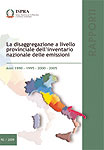The breakdown at the provincial level of the national inventory of emissions

This report describes how the apportionment of pollutants and greenhouse gases emissions’ estimates from the National Emission CORINAIR Inventory prepared by ISPRA (former APAT) has been carried out. Provincial (NUTS3) estimates have been computed for years 1990 - 1995 – 2000 - 2005 by applying a top-down approach. Emissions’ disaggregation has been implemented mostly on activity level.
Sector detail has been adopted only when required information was not available. The work involved a huge effort to collect various kinds of indicators such as demographic and economic indicators (e.g. population, car registration, airship passengers traffic), industrial production data (goods productions and consumption, electricity generated and so on) and some of the main patterns in land use, such as agricultural and forest areas, grassland, etc. A relevant contribution resulted from the availability, processing and comparison of the data related to some industrial point sources which are collected in the national registers: Emissions Trading, Italian EPER and LCP (Large Combustion Plants). A very large database containing more than 640,000 records, has been achieved. Several methodological aspects, working hypothesis and main results are described into about 300 analytical cards.
Thanks to this study, pollutant and greenhouse gases emissions are available for each of the 103 provinces of Italy and from the three target years’ estimates a temporal trend in the last 15 years may be also deduced. Results can be interpreted as useful cognitive elements for air quality and emissions control and management at a local scale (provincial and regional administrative level) and as a tool to study air pollution phenomena also over larger scale, involving more than one province. The usage of the same methodology and input database for activity indicators and proxy variables guarantees the comparability of resulting estimates.
